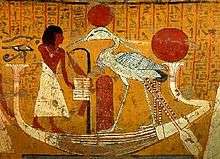Bennu heron
The Bennu heron (Ardea bennuides) is a large extinct heron from the United Arab Emirates. Its remains have been dated to 2700–1800 BCE, coinciding with the Umm al-Nar period.[1][2]
| Bennu heron | |
|---|---|
_-_TIMEA.jpg) | |
| Representation of the Bennu deity in Egyptian mythology, possibly based on the Bennu heron | |
| Scientific classification | |
| Kingdom: | Animalia |
| Phylum: | Chordata |
| Class: | Aves |
| Order: | Pelecaniformes |
| Family: | Ardeidae |
| Genus: | Ardea |
| Species: | A. bennuides |
| Binomial name | |
| Ardea bennuides Hoch, 1977 | |
It is thought that it may have been the inspiration for the Bennu in Egyptian mythology, hence the specific name.[1] It was very large, possibly about 2 m (6.6 ft) tall and with a wingspan up to 2.7 m (8.9 ft), thus surpassing the largest living species in the family, the goliath heron.[3]
References
- Hoch, Ella (1977). "Reflections on prehistoric life at Umm An-Nar (Trucial Oman) based on faunal remains from the third millennium B.C.". In M. Taddei (ed.). South Asian Archaeology 1977. Fourth International Conference of the Association of South Asian Archaeologists in Western Europe. pp. 589–638.
- Potts, D.T. "Before the Emirates: an Archaeological and Historical Account of Developments in the Region c. 5000 BC to 676 AD". CiteSeerX 10.1.1.630.7157. Cite journal requires
|journal=(help) - Callahan, D. (2014). A History of Birdwatching in 100 Objects. Bloomsbury Publishing Plc. p. 15. ISBN 978-1408-1-8618-3.
This article is issued from Wikipedia. The text is licensed under Creative Commons - Attribution - Sharealike. Additional terms may apply for the media files.

